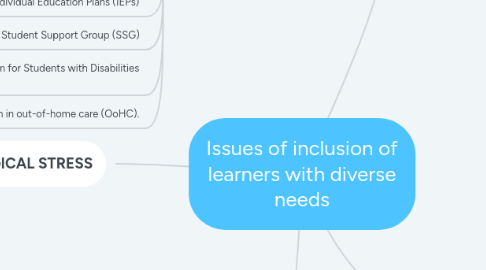
1. Inclusion
1.1. Invisible
1.1.1. ADHD
1.2. Visible
1.3. Invisible to the individual
1.4. Environmental
1.5. Physical, emotional, sexual, incaserated member of the household, parental separation, divorse
1.6. Poor school performance
1.6.1. negative health outcomes
1.6.1.1. looks bad on the school
1.6.1.1.1. effects funding
1.7. Let's take a look at five of the common barriers to participation that people with a disability may face. Attitude. People's perceptions of what it's like to live with a disability is one of the most foundational barriers. ... Communication. ... Physical. ... Policy. ... Social.
1.8. In life, everyone faces challenges and obstacles. But for someone with a disability on the NDIS, life’s challenges can have a much deeper impact and occur more frequently. When this happens, challenges can turn into barriers, which the World Health Organisation (WHO) defines as: “Factors in a person’s environment that, through their absence or presence, limit functioning and create disability.”
1.8.1. “Factors in a person’s environment that, through their absence or presence, limit functioning and create disability.” WHO
1.8.1.1. The barriers to disability aren’t always obvious, especially to able-bodied people.
1.9. The International Classification of Functioning, Disability and Health, known more commonly as ICF
1.9.1. International Classification of Functioning, Disability and Health (ICF)
1.9.1.1. As the functioning and disability of an individual occurs in a context, ICF
1.10. The ICF is a multipurpose classification system designed to serve various disciplines and sectors — for example in education (WHO 2001:5-6)
1.10.1. Hence, the ICF provides a valuable framework for monitoring aspects of the UN Convention on the Rights of Persons with Disabilities (UN 2006), as well as for national and international policy formulation.
1.10.1.1. ICF principles- universtility- disabled people shouldbe be a seperate social group
1.10.1.1.1. Parity and aetiological neutrality. In classifying functioning and disability, there is not an explicit or implicit distinction between different health conditions, whether ‘mental’ or 'physical'. In other words, disability is not differentiated by aetiology. By shifting the focus from health condition to functioning, it places all health conditions on an equal footing, allowing them to be compared using a common metric. Further, it clarifies that we cannot infer participation in everyday life from diagnosis alone.
1.11. Autonomy supported
1.12. stress management techniques in children, concentrating on psychological techniques (such as mindfulness and stress reappraisal), physiological techniques (such as breathing exercises) and environmental factors (such as reducing noise). At the current time, raising teachers' awareness of pupils' differing stress responses will be an important step in accommodating the differing needs of children in their classrooms.
1.13. Basically, IE means educating learners with special educational needs in regular education settings.
2. Inclusion
3. Intervention programs
3.1. AITSL
3.1.1. Modified assesment techniques
3.1.2. Adapted teaching methods
3.1.3. Accessibility arrangements
3.1.4. ILP Individual learning plan
3.1.5. Curriculum accomodations
3.1.6. Assistive Technology (AT)
3.2. Marrung, Aboriginal Education Plan 2016-2026
3.3. Individual Education Plans (IEPs)
3.4. Student Support Group (SSG)
3.5. Program for Students with Disabilities (PSD).
3.6. young person in out-of-home care (OoHC).
4. PSYCHOLOGICAL STRESS
4.1. Teacher
4.1.1. Professional Development
4.1.2. Strong Pedagogical beliefs
4.1.2.1. Maslow’s Hierarchy of school needs
4.1.2.2. Poststructuralist theory
4.1.2.2.1. 8 ways pedagogy
4.1.2.3. Pygmalion Effect
4.1.2.4. Reflective practice
4.1.2.5. Anti-bias curriculum
4.1.3. Teachers experiences
4.2. Weak collaberative ties between Steakholders
4.2.1. Privelage
5. NEOLIBERALISM
5.1. Government initiated support
5.1.1. The OECD project Overcoming School Failure: Policies that Work
5.1.2. SWAN's and ABLES (practical assessment tool)
5.1.3. ICF
5.1.4. SWPBS (School-Wide Positive Behaviour Support)
5.1.5. write a SMARTER objective for an ILP
5.1.6. Inclusive Education Scale (CIES)
5.1.7. CLARA Framework
5.1.8. Wellbeing, Health and Engagement Division
5.1.9. Australian Student Wellbeing Program
5.1.9.1. Engagement policy
6. OPPRESSION (Attitudes/beliefs)
6.1. Barriers to learning
6.1.1. Political agenders
6.1.1.1. School funding
6.1.1.2. ATAR -SNAP
6.1.1.3. Face of the school
6.1.1.4. Neoliberalism
6.1.2. inequality
6.1.2.1. Neurodivergent Students
6.1.2.1.1. Students with special education needs (SEN)
6.1.2.2. Able-challenged
6.1.2.2.1. Accessibility challenges
6.1.2.2.2. Students with special education needs (SEN)
6.1.2.3. Undiagnosed
6.1.2.3.1. General Anxiety Disorder (GAS)
6.1.2.3.2. Adverse Childhood Experiences (ACER)
6.1.2.4. Socio economic status (SES)
6.1.2.4.1. young person in out-of-home care (OoHC).
6.1.2.5. First nations people. Indigenous and Torres Strait Islanders
6.1.2.6. Self-concept
6.1.2.6.1. Beliefs from community
6.1.2.6.2. Beliefs from peers
6.1.2.6.3. Beliefs about oneself
6.1.2.6.4. Beliefs from the teacher
6.1.2.7. LGBTQIA+
6.1.2.8. Religion
6.1.2.9. Culture
6.1.2.9.1. First generation university
6.1.2.9.2. Refugees and asylum seekers
6.1.2.10. Ethnicity
6.1.2.10.1. students from culturally and linguistically diverse (CLD)
6.1.2.10.2. English Second Language (ESL)
6.1.2.11. Stereotypes
6.1.3. Environmental factors
6.1.4. Standardised testing NAPLAN
6.1.5. Minority stress

